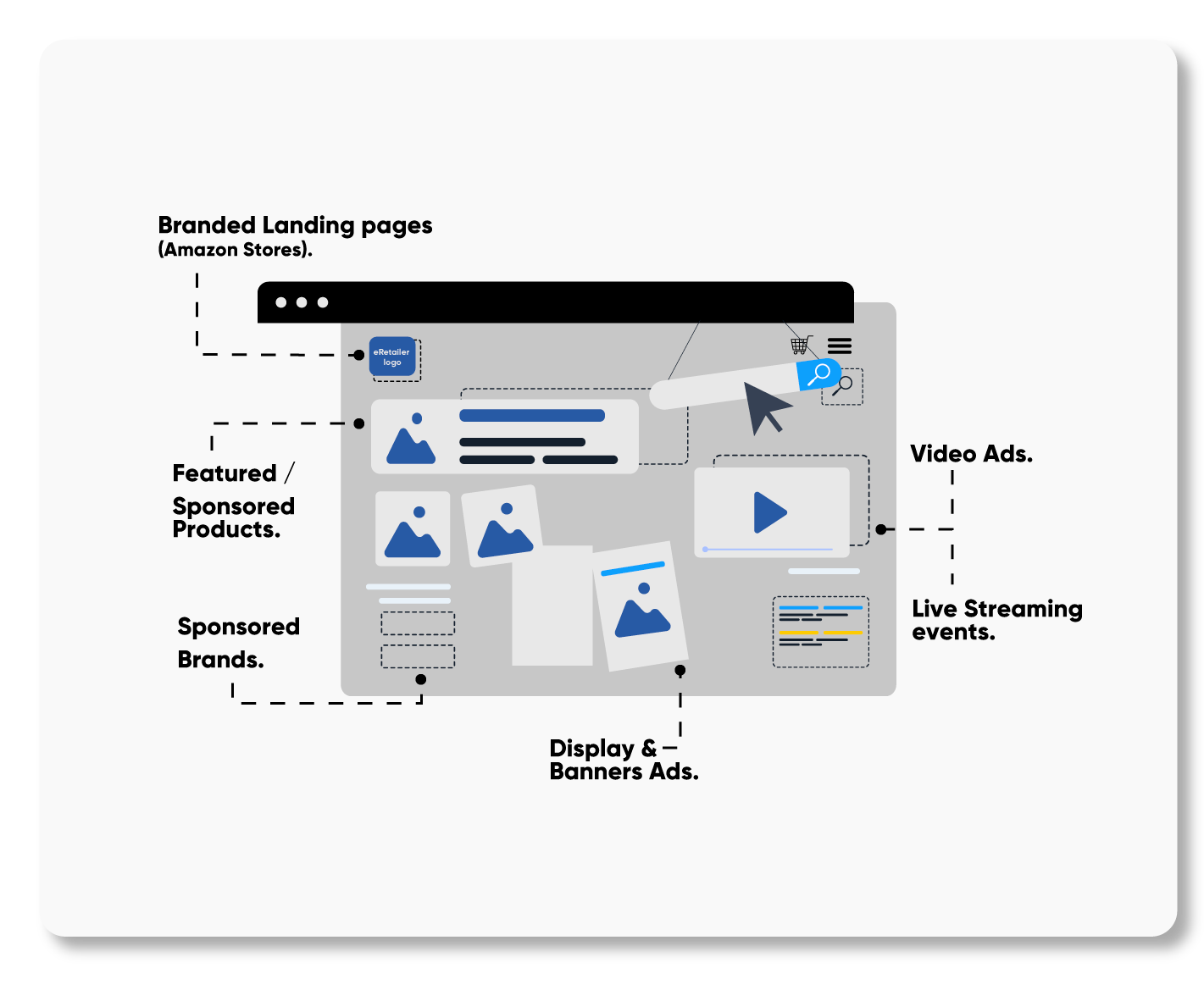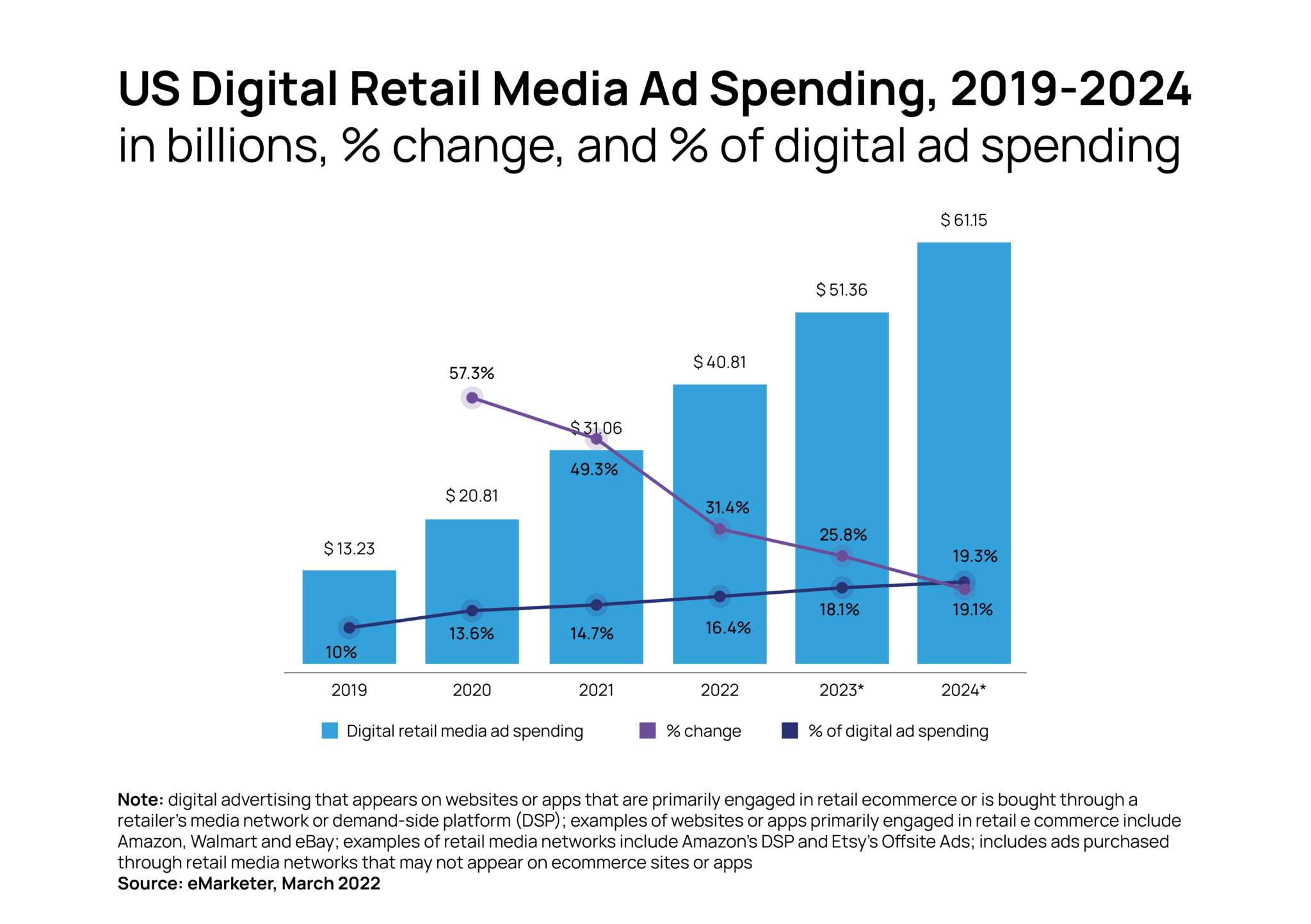Every click in today’s digital world represents a potential transaction, and every scroll is an opportunity for engagement. But in a market oversaturated with consumer content, brands are forced to compete for attention on the digital shelf. In response, retail media has emerged to provide brands with a pathway to stand out – bringing the promises of visibility and meaningful connections with buyers.
What is retail media?
Retail media refers to advertising and marketing efforts within the retail environment, both online and offline, aimed at promoting products and driving sales. It is a symbiotic ecosystem where retailers, brands, and consumers intersect to create mutually beneficial experiences.
At the heart of the retail media landscape are two primary stakeholders: retailers and brands. Retailers encompass a wide array of businesses, ranging from ecommerce giants like Amazon and Walmart to brick-and-mortar stores like Target and Kaufland. These retailers serve as the gatekeepers of consumer data and engagement, providing valuable insights into shopping behaviors and preferences.
On the other hand, brands encompass a diverse spectrum of products and services, spanning multiple industries, including consumer goods, electronics, fashion, and more. For brands, retail media presents an opportunity to amplify their visibility within the retail ecosystem, reaching consumers at the point of purchase and influencing their buying decisions.
What are retail media networks?
A retail media network (RMN) is a platform operated by a retailer that offers advertising space and promotional opportunities to brands within its digital ecosystem. These networks leverage the retailer's customer data to deliver targeted advertising campaigns, allowing brands to reach consumers at various touchpoints along their shopping journey. In essence, RMNs serve as intermediaries between retailers and brands, facilitating the monetization of digital assets and driving sales through targeted marketing initiatives.
For retailers operating their own RMNs, such as Amazon and Walmart, the advantages are plentiful. By leveraging first-party data and customer insights, these retailers can deliver hyper-targeted ads that resonate with their audience, ultimately driving sales and enhancing the overall shopping experience.
Similarly, adtech partners that support retailers in their retail media endeavors play a pivotal role in enabling seamless integration and campaign management. From demand-side platforms (DSPs) and supply-side platforms (SSPs) to data management platforms (DMPs), these partners offer a suite of tools and services designed to optimize ad spend and maximize ROI for brands.
Benefits of RMNs
Targeted advertising: RMNs enable brands to create highly targeted advertising campaigns based on rich customer data.
Increased visibility: Brands can significantly increase their visibility among consumers by placing ads within the retailer's digital ecosystem.
Enhanced customer engagement: RMNs provide opportunities for brands to engage with customers at various touchpoints along their shopping journey.
Improved conversion rate: By reaching consumers at the point of purchase, RMNs help brands drive higher conversion rates and sales.
Data insights: RMNs offer brands valuable insights into consumer behavior and preferences through data analysis.
Synergies with retailers: Collaboration between brands and retailers within RMNs creates mutually beneficial relationships, benefiting both parties. It’s also a great way for brands to increase their own sales with a retailer.
Types of ad inventory sold by retail media networks
Retail media networks offer a diverse array of ad inventory to brands, catering to various objectives and preferences. Some of the most common types of ad formats include:
- On-site retail media ads
On-site retail media ads refer to advertisements displayed directly on a retailer's digital platforms, such as their website or mobile app. These ads are strategically placed within the retailer's ecosystem to capture the attention of shoppers while they browse products or search for specific items.
Examples of on-site retail media ads include sponsored product listings, display ads, and native advertising.

Source: shalion.com
- Off-site retail media ads
Off-site retail media ads are advertisements displayed on external websites, platforms, or digital channels outside of the retailer's own ecosystem. These ads are designed to drive traffic back to the retailer's website or app, increasing brand visibility and generating sales.
Examples of off-site retail media ads include search engine marketing (SEM), social media advertising, and display network advertising.
- In-store retail media ads
In-store retail media ads are advertisements displayed within physical retail locations, designed to enhance the shopping experience and drive sales. These ads may include in-store digital signage, endcap displays, shelf talkers, and other promotional materials strategically placed throughout the store to attract shoppers' attention and influence purchasing decisions.
Overview of the retail media landscape
The retail media landscape is witnessing exponential growth, fueled by the increase in digital technologies and the shifting dynamics of consumer behavior. The RMN market size is expected to grow from $21.07 billion in 2023 to $31.7 billion in 2028 at a CAGR of 8.7%.

Source: clearcode.cc
Some of the top players in the retail media space include Amazon, Walmart Media Group, Target Media Network, and Kroger – each leveraging their extensive reach and data capabilities to drive impactful marketing initiatives. Amazon dominates the retail media ecosystem with ~45% market share and generated $47 billion from advertising in 2023 with 24% YoY growth.
Challenges of retail media
While the potential benefits of retail media are undeniable, it comes with its fair share of challenges. One of the primary concerns for retailers and brands alike is the issue of data privacy and consumer consent. With mounting regulatory scrutiny and increasing consumer awareness, ensuring compliance with data protection regulations has become paramount for stakeholders operating within the retail media ecosystem.
Additionally, the fragmented nature of the retail media landscape poses challenges in terms of sustainability, standardization and interoperability. As retailers and brands leverage multiple platforms and channels to reach their target audience, there is a growing need for unified measurement metrics and attribution models to accurately assess campaign effectiveness and ROI.
Recommendations for retailers and brands
For retailers looking to capitalize on the opportunities offered by retail media, it is essential to invest in robust technology infrastructure and data analytics capabilities. By leveraging AI and machine learning algorithms, retailers can gain valuable insights into consumer behavior and preferences, enabling them to deliver personalized shopping experiences and targeted advertising campaigns.
Similarly, brands should prioritize collaboration with retailers to optimize their retail media strategies and maximize ROI. By aligning their marketing objectives with the retailer's business goals, brands can ensure that their advertising efforts resonate with the target audience and drive tangible results.
As the retail media market continues to mature, collaboration and innovation will be key drivers of success, enabling brands to stay ahead of the curve and deliver meaningful experiences that resonate with consumers.
For a more in-depth look at the power of retail media, watch our webinar on-demand: The rise of retail media.
Or explore how Productsup's P2C platform offers a comprehensive solution for brands looking to optimize their ads across retail media networks with Advertising PX.


